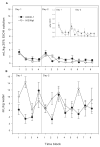Ethanol drinking microstructure of a high drinking in the dark selected mouse line
- PMID: 22524154
- PMCID: PMC3407303
- DOI: 10.1111/j.1530-0277.2012.01749.x
Ethanol drinking microstructure of a high drinking in the dark selected mouse line
Abstract
Background: The High Drinking in the Dark (HDID) selected mouse line was bred for high blood ethanol (EtOH) concentration (BEC) following the limited access drinking in the dark (DID) test and is a genetic animal model of binge-like drinking. This study examines the microstructure of EtOH drinking in these mice and their control line during 3 versions of the DID test to determine how drinking structure differences might relate to overall intake and BEC.
Methods: Male mice from the HDID-1 replicate line and HS/Npt progenitor stock were tested in separate experiments on 2- and 4-day versions of the DID test, and on a 2-day 2-bottle choice DID test with 20% EtOH and water. Testing took place in home cages connected to a continuous fluid intake monitoring system, and drinking during the DID test was analyzed for drinking microstructure.
Results: HDID-1 mice had more drinking bouts, shorter interbout interval, larger bout size, greater total EtOH intake, and higher BECs than HS/Npt mice on the second day of the 2-day DID test. The 4-day DID test showed greater bout size, total EtOH intake, and BEC in the HDID-1 mice than the HS/Npt mice. Total EtOH intake and BECs for the HDID-1 mice in the DID tests averaged 2.6 to 3.0 g/kg and 0.4 to 0.5 mg/ml, respectively. The 2-bottle choice test showed no genotype differences in drinking microstructure or total consumption but did show greater preference for the EtOH solution in HDID-1 mice than HS/Npt.
Conclusions: These results suggest that inherent differences in EtOH drinking structure between the HDID-1 and HS/Npt mice, especially the larger bout size in the HDID-1 mice, contribute to the difference in intake during the standard DID test.
Copyright © 2012 by the Research Society on Alcoholism.
Figures








References
-
- Armstrong S. A chronometric approach to the study of feeding behavior. Neuroscience & Biobehavioral Reviews. 1980;4(1):27–53. - PubMed
-
- Boughter JD, Jr, Baird J-P, Bryant J, St John SJ, Heck D. C57BL/6J and DBA/2J mice vary in lick rate and ingestive microstructure. Genes Brain Behav. 2007;6(7):619–627. - PubMed
-
- Canu ME, Carta D, Murgia E, Serra G, D’Aquila PS. Dopamine on D2-like receptors is involved in reward evaluation in water-deprived rats licking for NaCl and water. Pharmacol Biochem Behav. 2010;96(2):194–197. 2010. - PubMed
Publication types
MeSH terms
Substances
Grants and funding
LinkOut - more resources
Full Text Sources
Medical

